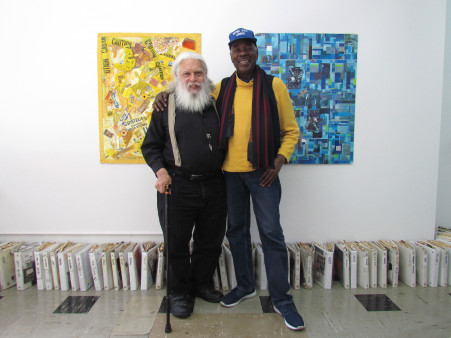Locations can inspire art. For writer Samuel R. Delany, famous for his science fiction, and artist Frederick Weston, best known for his collages, you could say their muse is Times Square—but not today’s sleek, Disneyfied version. Instead, as the two men reveal in the latest installment of Duets, Visual AIDS’s series of publications featuring conversations between artists, their beloved Times Square existed in the last decades of the 20th century and was a seedy hub of porn theaters and hustler bars where folks not only explored sexual desires but also found community and friendship.

The cover of “Duets”, which features Weston’s Self-Portrait, 1979, created with dot matrix print and tapeCourtesy of Visual AIDS
For Weston, Times Square also offered employment. Among other places, he worked in the coat check at Stella’s, on West 47th Street, where he snapped Polaroids of the bar’s denizens and at one point transformed the headshots into an art installation that covered the walls. “I was always doing collages, taking pictures and photocopying them,” the HIV-positive artist tells Delany. “I think I’m really kind of a painter, but I don’t paint with paint, I paint with pieces of paper.”
The first work he sold was Water/Bed (1999), a collage from an exhibit at Village Care, his HIV day-treatment program. Over the years, his work grew in scope and scale, allowing him to delve into personal issues such as race and depression—though he notes it took a while after his HIV diagnosis before the subject appeared in his work, including his poetry and performance pieces.
Delany is HIV negative, which he tells Weston is likely a result of the fact that he didn’t like penetrative sex and preferred to perform oral sex in porn theaters. (Their frank and unapologetic conversation will surely be a shock to some readers.)
Sadly, Weston died of cancer in 2020 before this Duets was completed but not before making his mark. As The New York Times noted in his obituary, “for decades he made his art in dingy Manhattan hotel rooms living hand-to-mouth, hoping for his big break. It finally arrived just a few years before his death.” He was 73.
In a blog post about Weston’s passing, Visual AIDS, which uses art to fight HIV and support HIV-positive artists, wrote, “We are grateful for the many ways he brought his visionary talent and personal warmth to our lives and to our programs. He spoke and performed original poetry at our public events, led education workshops, contributed to exhibitions and was a valued member of our archive and our community. Fred lived near our office and would often stop by for visits that were the highlight of our week. We will feel a keen sense of loss without Fred’s creativity, his warm and welcoming personality, his sartorial style, his iconic double hugs and his signature sign-off, ‘Bye for now!’”











Comments
Comments